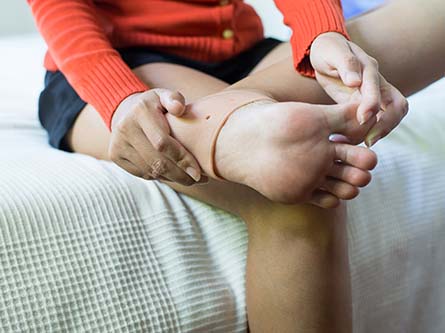
Plantar fasciitis is the leading cause of heel pain in adults. About 1 in 10 people will experience plantar fasciitis at some point in their lives, with it affecting more women than men. Plantar fasciitis is one of the most common foot complaints physicians see at UC Davis Health Sports Medicine.
Cause of plantar fasciitis
The disorder is caused by strain in the plantar fascia. This is the thick, web-like tissue under the skin at the bottom of the foot that extends from the heel to the toes.
Patients with plantar fasciitis experience pain in their heel or arch. Often, the first step out of bed in the morning is the most painful.
You can think of it like a rubber band from your heel to your toes. If the band is loose while you're sleeping, your first step pulls on the rubber band. This causes lots of pain.
Sign up for our Health Highlights e-newsletter
Plantar fasciitis risk factors
It's not just runners and other athletes who are at higher risk for plantar fasciitis. People whose jobs require standing on hard surfaces, such as teachers, nurses, and mail carriers, are also at risk for plantar fasciitis.
Other risk factors include obesity, an inactive lifestyle, high or low arches of the foot, and low flexibility of the Achilles tendon or calf muscles.
Physicians caution people who want to begin an exercise routine to be patient. Remember to stretch and go slow to avoid problems like plantar fasciitis.
Plantar fasciitis treatments: What are the best ways to relieve pain?
Patients who manage their plantar fasciitis symptoms usually get better in about a year. You can help improve your plantar fasciitis by stretching your lower legs, focusing on the calf muscles. It also helps to get shoes with good arch support.
For anyone with plantar fasciitis who would still like to stay physically active, cross-training such as swimming or biking can help lessen foot pain. Runners can use a specific taping technique to take pressure off the fascia and should get new shoes regularly to keep good cushioning.
After the gym or a long day at work, our physicians recommend "RICE":
- Rest
- Ice
- Compression
- Elevate
Also, try stretching before bed, and consider a night splint. You can also freeze a 16 oz. water bottle and roll it over your foot to help relieve pain.
If plantar fasciitis symptoms continue or worsen, there are other options to help with your quality of life. Physical therapy is very important for patients who have plantar fasciitis. If other treatments don't work, further options include steroid or platelet-rich plasma injections, shock wave therapy, or surgery to lessen the pain.
See how to make an appointment with our sports medicine specialists
How to confirm you have plantar fasciitis
While plantar fasciitis is common, patients should make sure they actually have it. Nerve injuries such as tarsal tunnel syndrome, stress fractures, or autoimmune disorders can cause similar foot pain.
You can make an appointment at the UC Davis Sports Medicine clinic to get a clear diagnosis and treatment options. This allows you to work with a specialist on a specific issue and make sure you're treating it correctly.
The sports medicine team at UC Davis Health includes specialists in the following areas to support each patient's needs:
- orthopaedic surgery
- foot and ankle disorders
- physical medicine and rehabilitation
- biomedical engineering
This blog posts was written by Marcia Faustin, family and community medicine and sports medicine physician.




